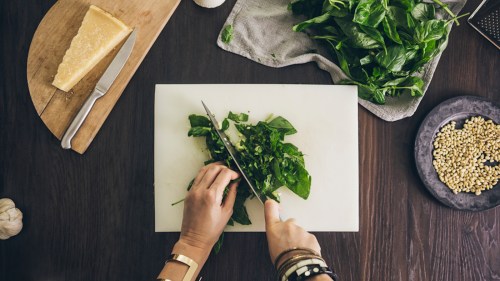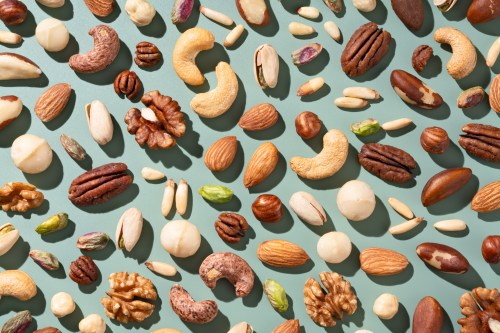Our editors independently select these products. Making a purchase through our links may earn Well+Good a commission
Even though there’s a heck of a lot of plant-based foods out there, greens are often thought of as one of the foundational foods of plant-based eating. This is because they have high concentrations of vitamins, nutrients, and minerals. They’re also inexpensive and widely accessible; even in the dead of winter, there’s still plenty of varieties of greens that are in season.
Experts in This Article
Kaitlin Mogentale is the CEO of Pulp Pantry, a food company that makes snacks out of would-be waste.
Reilly Brock is the associate creative director at Imperfect Foods, a food delivery company with the mission of eliminating food waste and making healthy food more accessible.
As food blogger and Healthier Together author Liz Moody points out in Well+Good’s ReNew Year program, greens are also exceptionally versatile. You do not need to love salad to love greens. In fact, coming up with ways to use them beyond the salad bowl is one of Moody’s tips for sticking with plant-based eating long-term.
Need some ideas? Here, Reilly Brock, the associate creative director at Imperfect Foods, and Pulp Pantry CEO and founder Kaitlin Mogentale, both give their tips on how to cook with winter greens, touching on each different type.
Keep reading to see how to cook with winter greens.
Arugula
If you *are* going to use winter greens to make a salad, both Mogentale and Brock say arugula is a great option. “Arugula is amazing as a salad green, especially wild arugula,” Mogentale says. Her favorite dressing to pair arugula with is a maple tahini dressing or balsamic vinaigrette. “The sweetness of both can help to balance any bitterness from the greens,” she says.
Pro tip from Brock: Incorporate a fatty nut or cheese into your winter salad to balance out arugula’s biting, peppery flavor. “You’ll definitely want something salty or earthy too, so the arugula doesn’t totally dominate the salad,” he says, adding that a couple of his go-tos are roasted beets or red pepper. “It’s a good way to round out the flavor,” he says.
Speaking of arugula salad, you have to try this delicious wintery recipe:
Mustard greens
Like arugula, mustard greens have a strong flavor profile. “They’re probably the most assertive winter green,” Brock says, adding that this is what he thinks makes cooking with them fun. He recommends sauteeing mustard greens and incorporating other bold spices and oils. “Garlic, ginger, chili peppers, sesame oil…anything that has a bold flavor of its own works well with the peppery taste of mustard greens,” he says.
One of Brock’s favorite ways to eat mustard greens is in a frittata with eggs, roasted red pepper, and sweet potato. “Mustard greens can also hold their own when paired with pork or poultry, which is a more Italian way of eating them,” he says, as proven by this anti-inflammatory skillet recipe with sausage, cabbage, and mustard greens.
Chard
“My favorite way to use chard is a simple sautee,” Brock says. “Just put it in a pan with a little garlic and olive oil. Then, finish it with lemon juice.” He adds that chard cooks quickly, so it’s a great green to have on hand to sautee quickly and can easily be combined with tofu, eggs, or other proteins.
Brock says some people find chards’ stems too fibrous to enjoy sauteed, in which case he recommends pickling them. “They’re quite good as a sweet pickled food, so if you’re overwhelmed by the stems’ taste or texture, it’s a good way to use them,” he says.
Looking for another way to use chard? Try these delicious chard wraps:
Radish greens
The tops of your radishes—and carrots—are an underutilized winter green that can taste delicious when prepared correctly. Mogentale likes to incorporate hers into a pesto sauce. “Because of their tough texture, just blanch them for about two minutes first,” she says. Then, dry them and add them to the food processor with your other pesto ingredients.
Brock says he likes to cook the radish bulbs—and the greens—on the stove with butter and serve them as a side salad. “They have a bitter earthiness that tastes good with a little lemon juice or sherry vinegar,” he says. Like chard stems, Brock says radish greens can also be pickled.
Romaine
Sure, you can use romaine in a standard salad, or you can get a little creative and grill them. “Grilled romaine is so delicious and it’s fibrous enough where it won’t fall apart on the grill,” Brock says. “It’s sweet, smokey, and makes a fun Cesar salad.” So next time you have a couple of friends over for a pandemic-friendly outside dinner, this could be something fun to serve up.
Eating inside? Mogentale uses her romaine leaves as lettuce boats. She says they can work as veggie taco shells, holding taco crumbles, cheese, and salsa. Or, use them to hold hummus, quinoa, feta cheese, and olives for a Mediterranean-inspired meal.
Spinach
Spinach has a more mild taste than some of the other winter greens on this list and Brock says this means it can be worked into pretty much anything. His number one tip is to cook it, playing with a variety of herbs in your pantry. “In the States, we often don’t spice up our greens, but this is done in so many cultures and can completely change how they taste,” he says. For example, he says in India, spinach is often used in curries; in North Africa, it’s a primary ingredient in many stews.
“I think we’ve all been guilty of making an ambitious purchase of a big bag of spinach only to not use it all. Spinach cooks down really quickly, so use that to your advantage and cook it to really use what’s in that bag,” he says.
When it comes to getting your fill of winter greens, both experts emphasize thinking outside the salad bowl. “Get creative and don’t limit yourself,” Brock says. “There are so many fun ways to eat your greens.”
Enjoy this guide for how to cook with winter greens? Get more healthy meal ideas in Well+Good’s Cook With Us Facebook group.
Sign Up for Our Daily Newsletter
Get all the latest in wellness, trends, food, fitness, beauty, and more delivered right to your inbox.
Got it, you've been added to our email list.










